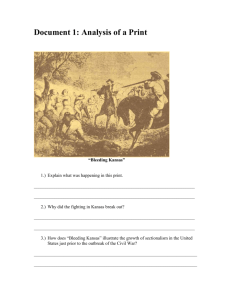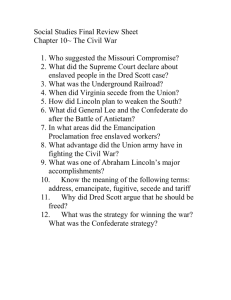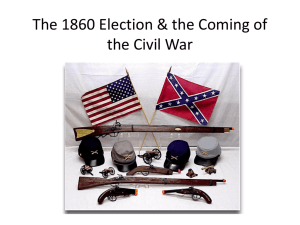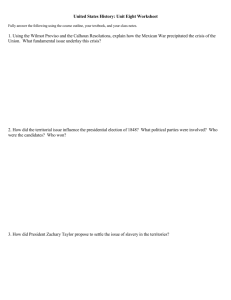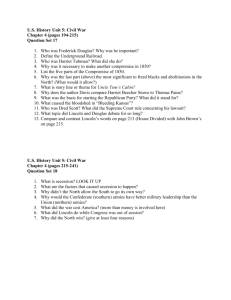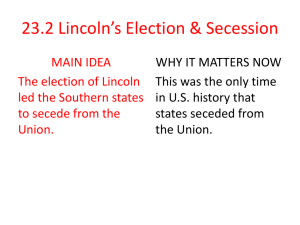chapter 13 - Bakersfield College
advertisement
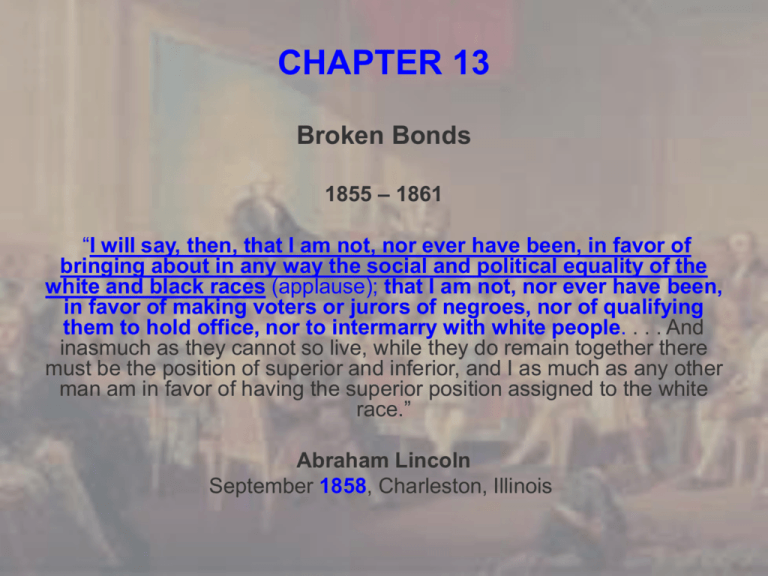
CHAPTER 13 Broken Bonds 1855 – 1861 “I will say, then, that I am not, nor ever have been, in favor of bringing about in any way the social and political equality of the white and black races (applause); that I am not, nor ever have been, in favor of making voters or jurors of negroes, nor of qualifying them to hold office, nor to intermarry with white people. . . . And inasmuch as they cannot so live, while they do remain together there must be the position of superior and inferior, and I as much as any other man am in favor of having the superior position assigned to the white race.” Abraham Lincoln September 1858, Charleston, Illinois Overview Overview Overview (continued) Chronology 1832 1848 1850 1851 1852 1854 1855 1856 1857 1858 1859 1860 1861 Nullification Crisis Treaty of Guadalupe Hidalgo; Zachary Taylor; "free-soilers" Compromise of 1850; American "know nothing" movement; Millard Fillmore president Northern reaction to the Fugitive Slave Law; Harriet Beecher Stowe’s Uncle Tom’s Cabin Franklin Pierce elected president Ostend Manifesto; Kansas-Nebraska Act; treaty renegotiations; Republican Party begins William Walker’s "filibuster" in Nicaragua Looting of Lawrence, Kansas; John Brown’s Pottawatomie massacre; Buchanan president Dred Scott decision; Buchanan accepts proslavery Lecompton constitution; Panic Congress rejects Lecompton constitution; Lincoln-Douglas John Brown’s raid at Harper’s Ferry 4 candidates for president; Lincoln’s election; S. secession 6 additional "deep South" states secede; Confederate States formed, Lincoln takes Chapter Review Define popular sovereignty and explain how the political parties of the mid-nineteenth century used it to shape their particular political agendas. Explain how events in Kansas contributed to problems for the Democratic Party. Describe the political issues surrounding the Dred Scott case and the significance of the subsequent Supreme Court decision. Briefly explain the various Southern viewpoints on the issue of slavery in the 1850s. Explain the political positions of Stephen A. Douglas and Abraham Lincoln on the eve of their 1858 debate series. Explain the significance of the 1860 presidential election. Why did the deep South secede from the U.S.? Concepts Harper’s Ferry, John Brown, Robert E. Lee William Walker, filibuster Yeoman Border ruffians Charles Sumner Bleeding Kansas James Buchanan Roger B. Taney, Dred Scott case Abraham Lincoln Lincoln-Douglas debates Fort Sumter I. North and South Collide White South uses variety of arguments to justify slavery, while critics of slavery point to economic “backwardness” Popular sovereignty and Kansas-Nebraska Act bring violence to nation Republican party vows to halt spread of slavery Dred Scott case clarifies differences within country The New York City torchlight meeting of the “Know-Nothings” or the American Party in Nov. 1855 Ripon, Wisconsin schoolhouse where Republicans first met John C. Fremont, first Republican candidate for president, US Senator from California Dred Scott Dred Scott and his wife Harriet are portrayed here with their children as an average middleclass family, an image that fueled Northern opposition to the Supreme Court’s 1857 decision that denied both Scott’s freedom and his citizenship. Courtesy of Library of Congress Dred and Harriet Scott. He argued his residency in Wisconsin made both of them free. Chief Justice Roger Taney, primary author of the Dred Scott Decision of 1857. Kansas-Nebraska and the Slavery Issue Election of 1856 ©2004 Wadsworth, a division of Thomson Learning, Inc. Thomson Learning™ is a trademark used herein under license. Democrat James Buchanan, elected president in 1856. II. American Society in Crisis Panic of 1857 spurs religious revival Kansas remains cauldron of unrest 1858 senatorial elections bring Abraham Lincoln to attention of Republican leaders John Brown’s raid on Harper’s Ferry polarizes nation John Brown’s “fort” at Harper’s Ferry The arraignment of John Brown at Charles Town, West Virginia John Brown John Brown, wounded during his raid on the federal arsenal at Harpers Ferry, lies on a cot during his trial for murder and treason in Charlestown, Virginia, in 1859.The Granger Collection, New York Path of Lincoln-Douglas debates ©2004 Wadsworth, a division of Thomson Learning, Inc. Thomson Learning™ is a trademark used herein under license. Scene of 5th Lincoln – Douglas debate Springfield, Illinois street where Lincoln had his law office. Lincoln’s home in Springfield, Illinois Lincoln’s kitchen in Springfield, Illinois III. The North and South Call Each Other’s Bluff Republican Lincoln wins North and wins 1860 election, splitting nation even more South Carolina chooses secession and urges other states to follow The Election of 1860 The election returns from 1860 vividly illustrate the geography of sectionalism. Election of 1860 ©2004 Wadsworth, a division of Thomson Learning, Inc. Thomson Learning™ is a trademark used herein under license. Abraham Lincoln in 1860 Stephen Douglas, the “Little Giant” IV. The First Secession Lincoln’s inaugural address clarifies his position but fails to satisfy South Attempts to relieve Fort Sumter draw fire and plunge country into war Fort Sumter Confederate Soldiers at Pensacola against Fort Pickens The Road to Disunion North-South Differences John Brown’s Raid The Election of 1860 Abraham Lincoln, Stephen Douglas and John C. Breckinridge, Constitutional Party John Bell Secession Begins Presidential Inaction Peace Proposals John C. Crittenden, Jan. 1861 and former pres. John Tyler in Feb. 1861 – Crittenden wanted to extend Missouri Compromise line through CA but South disinterested Lincoln’s Views on Secession Election of 1860 and Southern Secession
